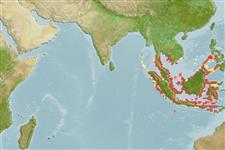Common names from other countries
Environment: milieu / climate zone / depth range / distribution range
Ecologia
; intervalo de profundidade 0 - 1 m (Ref. 119695). Tropical; 12°N - 12°S, 91°E - 123°E (Ref. 119694)
Indo-West Pacific.
Length at first maturity / Tamanho / Peso / Idade
Maturity: Lm ? range ? - ? cm Max length : 100.0 cm TL macho/indeterminado; (Ref. 8812); Peso máx. publicado: 1.6 kg (Ref. 356)
Total Length: 89 to 100 cm; Wingspan: 206 to 230 cm (Ref. 8812). Minimum and maximum depth ranges are based on feeding behavior of dipper types of seabirds (Ref. 119695). This is to be replaced with better references. Surface feeding; scavenging; kleptoparasitism; oceanic; warm, low-salinity waters of the south Equatorial Current (Ref. 356).
Li, X. 1990. (Ref. 78638)
Status na Lista Vermelha da IUCN (Ref. 130435)
Status no CITES (Ref. 108899)
Uso pelos humanos
| FishSource |
Ferramentas
Fontes da internet
Estimates based on models
Preferred temperature
(Ref.
115969): 9.1 - 20.3, mean 11.8 (based on 122 cells).
Vulnerabilidade
High vulnerability (60 of 100).
Categoria de preço
Unknown.
